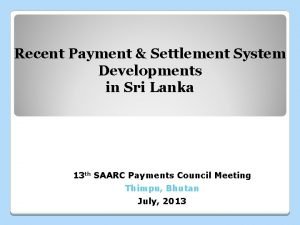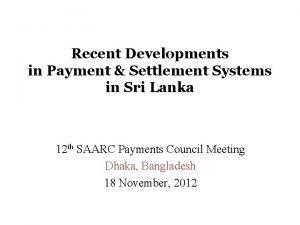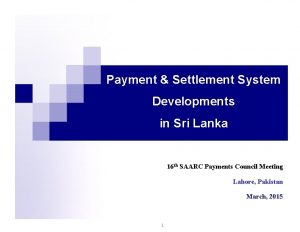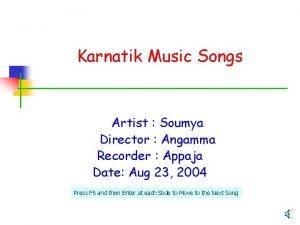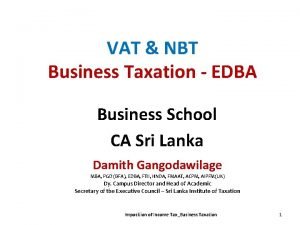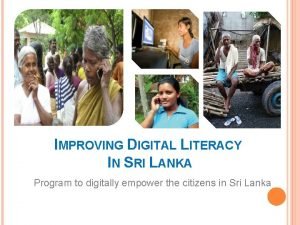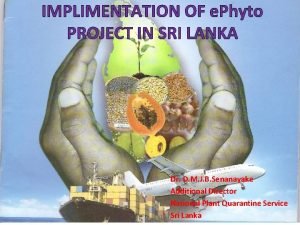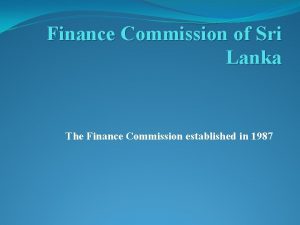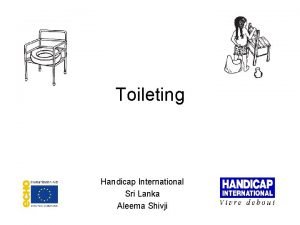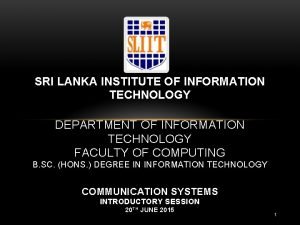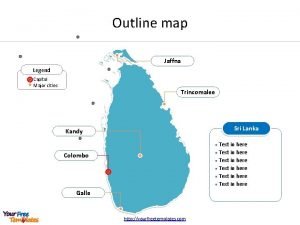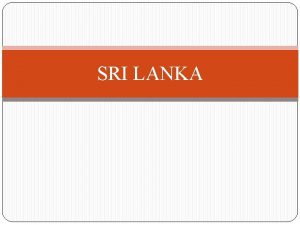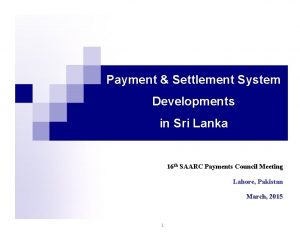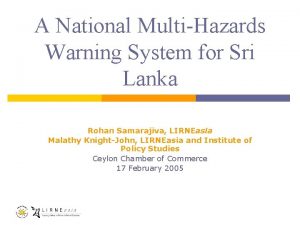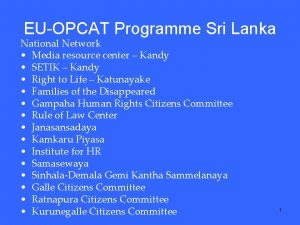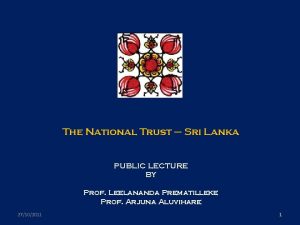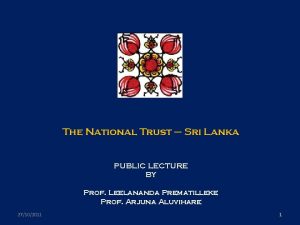The National Payment System in Sri Lanka D



























- Slides: 27

The National Payment System in Sri Lanka D Kumaratunge Director- Payments and Settlements Central Bank of Sri Lanka

Payment Systems and Instruments in Sri Lanka Large Value Payment System - Real Time Gross Settlement System Retail Payment Systems and Instruments - Cheques - Sri Lanka Interbank Payment System (SLIPS) Common Electronic Fund Transfers (CEFT) - Payment Cards - Mobile Payments - Internet Banking - Postal Instruments 2

Transactions effected through Payment Systems (2017) 3 2010 PAYMENT SYSTEM Volume Value ('000) (Rs. bn) Large Value Payment Systems RTGS System 2017 247 Retail Value Payment Systems 47, 806 377 92, 303 Main Cheque Clearing System 42, 795 5, 346 51, 963 10, 482 Sri Lanka Interbank Payment System (SLIPS) 12, 530 332 30, 018 1, 725 Credit Cards 16, 451 75 36, 964 199 Debit Cards 5, 340 16 46, 964 135 Internet Banking 4, 264 269 23, 066 2, 101 229 5 3, 809 32 - 10 1, 308 7 Phone Banking Postal Instruments

Real Time Gross Settlement System (RTGS) • Launched in 2003, replacing the interbank cheque based high value settlement system • CBSL is the owner and operator of the RTGS system • Currently there are 36 participants • 25 Commercial Banks (All commercial banks in Sri Lanka) • 8 Primary Dealers (all primary dealers in Sri Lanka excluding bank primary dealer units) • Employees’ Provident Fund (the largest superannuation fund in Sri Lanka) • Central Depository System of the Colombo Stock Exchange • Central Bank of Sri Lanka 4

Reasons for moving to the RTGS system • Less Credit Risk for Participants • Less impact for other participants in the event of a failure of a participant during business hours. • Participants get full control of their own and customers’ payments and better liquidity management. • Can efficiently manage the growth in the volume of transactions. • Increased public and investor confidence due to less risk and high efficiency • No physical exchange of money. (currency printing cost for the Central Bank in 2017 - Rs. 1. 5 Billion) 5

Transactions going through the RTGS system Interbank Call money market transactions Fund settlements of the government securities transaction Open Market Operations Sri Lankan Rupee leg of foreign exchange market transactions Large Value payments of customers Net obligations under the clearing systems operated by the only clearing house in Sri Lanka- Lanka. Clear (Pvt) Ltd (LCPL) • Provision and settlement of Intra Day Liquidity. • No minimum or maximum per transaction limit. • • • 6

The retail payment system and Instruments • • Cheques Sri Lanka Interbank Payment System (SLIPS) Common Electronic Fund Transfer (CEFT) Payment Cards Mobile Payments Internet Banking Postal Instruments 7

Cheques • All Sri Lankan Rupee (LKR) cheques and drafts are cleared by Lanka. Clear (Pvt. ) Ltd. (LCPL) through the Cheque Imaging and Truncation (CIT) System • Through CITS, the efficiency of cheque clearing was increased by stopping the physical movement of cheques • The presenting bank submits an image of the cheque to the clearing house • With the introduction of the CIT system, cheque realization time was reduced to the following business day. 8

SLIPS • SLIPS was introduced as an offline payment system in 1994 by the Sri Lanka Automated Clearing House (SLACH) operating under the CBSL • In September 2010, SLIPS was upgraded to an online payment system • Handles small value payments in the nature of ; • credit transfers (i. e. pushing funds from transferor’s account to transferee’s account) and • direct debits (i. e. pulling funds from the transferor’s account on the instructions given by the transferee subject to prior authorization granted by the transferor). • Multilateral net clearing balances of SLIPS are settled three times daily on each business day in the RTGS system • SLIPS is mainly used for salary and pension payments. • The maximum amount per transaction is LKR five (05) million 9

SLIPS Transaction types Credit Transfers • Salaries • Standing orders (e. g. loan repayments) • Insurance premium payments • Pensions • EPF repayments / ETF repayments • Dividends 10 Direct Debits • Utility Bill Payments (Telephone, Electricity, Water Bills) • Credit Card Payments • EPF Contributions collection • ETF Contributions collection • Lease payments • Insurance payments • Share purchase collections

Payment Cards • In Sri Lanka, payment card issuers mostly issue payment cards under international card schemes such as Visa, Master. Card, Amex and payment cards can only be issued by institutions licensed by CBSL for card issuing. • Lanka. Clear (Pvt) Ltd is in the process of introducing a National Card Scheme (NCS) in partnership with an international card scheme to reduce costs incurred by cardholders and merchants on domestic payment card transactions • Most of the card transactions are done as payments via Point of Sales (POS) machines or cash withdrawals at Automated Teller Machines (ATMs) • All card transactions effected overseas will be debited after converting the value into local currency 11

Payment Card Types 12 Cards which enable its holders to make purchases and/or withdraw cash and have these transactions directly charged to their accounts maintained at a financial institution BUY NOW PAY NOW Cards which enable its holders to make purchases and/or withdraw cash up to an authorized credit limit. The utilized credit amount can be settled in full or in part with the balance taken as extended credit on which interest is charged BUY NOW PAY LATER Charge Cards which enable its holders to make purchases and/or withdraw cash up to an authorized limit and settle the outstanding amount in full at the end of a specified period BUY NOW PAY LATER Stored Value Cards A card on which monetary value is stored to be used by the holder to make purchases and/or withdraw cash PAY NOW BUY LATER Debit Cards Credit Cards

Mobile Payments • Can be described as payments effected using mobile phones as the payment instrument, where the payment instructions are communicated through the use of mobile phones • Mobile payment systems can be classified into two categories; namely, • customer account based mobile payment systems • mobile phone based e-money systems • Mobile phone based banking services offered by financial institutions are of three types; • Basic Type Services • Standard Type Services • Extended Type Services 13

Mobile Payments- Two Categories • Customer account based mobile payment systems – • Customer has an account in the financial institution which provides the mobile payment system and the customer can give payment instructions via the application • Mobile phone based e-money systems– • Payments done as e-money transfers from one account to another’s. Emoney is purchased by paying an equivalent amount of physical cash to the operator 14

Customer Account based Mobile Payment Systems 15 BASIC TYPE STANDARD TYPE EXTENDED TYPE ( INFORMATION SERVICES) ( FUND TRANSFERS ) ( OPERATED THROUGH AGENTS ) • Balance Inquiry • Own Account Fund Transfers • Record of previous transactions • Third-Party Fund Transfers • Other financial information • Utility Bill Payments • Stop Payments • Facility to deposit/withdraw cash through agents appointed by the respective banks

Mobile Phone Based e-money systems: Regulatory Requirement Service providers should open and maintain a custodian account in a licensed commercial bank, in which physical money collected from customers should be deposited. Cumulative sum of e-money balances should always be equal to the balance in the custodian account. CUSTODIAN ACCOUNT Rs. 1000/= E 500 E 300 E 200 16

Internet Payments • Internet payments are payments executed using the Internet as the payment channel to communicate payment instructions • Internet banking and payments through the internet using payment cards are also taken as internet payments • Interbank fund transfers initiated through internet banking are effected through the Common Electronic Fund Transfer Switch (CEFTS) • Payments through the internet using payment cards can be done to both local and overseas merchants 17

Postal Instruments • Post offices, which are scattered nationwide, issue money orders and postal orders mainly to facilitate person-to-person fund transfers • Mainly used to make small value payments to individuals and institutions and to pay pension and social security payments by government • The usage of postal instruments has shown a declining trend during the past few decades • The Postal Department introduced electronic money orders to make the fund transfers faster 18

Common Card and Payment Switch (CCAPS) • The operations of CCAPS commenced in 2003 under the brand name “Lanka. Pay” • CCAPS consists of five sub-switches; • • • Common ATM Switch (CAS) Common Electronic Fund Transfer Switch (CEFTS) Shared ATM Switch (SAS) Common Point-of-Sale Switch (CPS) Common Mobile Switch (CMobs) 19

20 Common Cards and Payments Switch (CCAPS) Common ATM Switch (CAS) • Launched in July 2013 • As at end of Q 1 2018: 28 FIs have joined connecting nearly 4, 500 ATMs Common Electronic Fund Transfer Switch (CEFTS) Common POS Switch (CPS) Common Mobile Switch (CMob. S) Facilitate routing • Launched in August Provide ATM switching facility for FIs who do not of domestic POS 2015 have their own switch transactions • As at end of Q 1 2018: • To be 34 FIS have joined • Launched in August implemented 2015 with RDB Facilitate mobile wallet transactions Shared ATM Switch (SAS) • To be implemented

Common ATM Switch (CAS) • Provides interconnectivity among domestic ATM networks of financial institutions which enables secure ATM access for cardholders at ATMs of other financial institutions • Not-on-us Cash Withdrawals and Balance Inquiries are possible at any connected ATM • CAS promotes sharing of ATM infrastructure among financial institutions minimizing the duplication of costs related to ATM installation and maintenance • CAS went live in 2013 and is operated by Lanka. Clear (Pvt) Ltd • The final settlement of CAS transactions is effected in the RTGS System as a multilateral net settlement 21

Common Electronic Fund Transfer Switch (CEFTS) • The instant small value fund transfer system in Sri Lanka • A Liability is created for the fund recipients bank as the settlement between the banks happen at a later time, (predefined) in RTGS, even though the funds get transferred real time • A customer can carry out a CEFTS transaction, • Over the counter • Using Bank’s ATM • Using the Bank’s internet banking facility • The maximum per transaction limit is SLR five million. 22

Common Electronic Fund Transfer Switch (CEFTS) CEFTS facilitate real time fund transfers through different payment channels. Internet Mobile ATMs or Kiosks Over the Counter A common infrastructure for switching domestic interbank electronic fund transfers on real-time in 24 X 7 Maximum per transaction value of CEFTS is Rs. 5 million and the maximum per transaction fee that can be charged from a customer is Rs. 50/= through direct channels and Rs. 100/= through indirect channels. Used for effecting government payments - Lanka. Pay Online Payment Platform 23

Shared ATM Switch • The main objective of establishing Shared ATM Switch is to provide a hosted ATM Switch and card management system for financial institutions which do not have the capacity to operate their own card management system • Operated by Lanka. Clear (Pvt) Ltd 24

Regulation and Supervision of Payment Services in Sri Lanka • The Monetary Law Act in Sri Lanka states that CBSL is responsible for administration, supervision and regulation of the payments system of the country • Payment and Settlement Systems Act has empowered CBSL to regulate and supervise payment, clearing and settlement systems of the country • Regulatory documents are issued by CBSL • with a view to mitigate risks associated with payment systems and thereby to ensure payment system safety and stability • CBSL engages in risk based supervision in two ways, namely on-site examinations and off-site surveillance. 25

New developments in the Payments and Settlements field in Sri Lanka • In order to achieve a less-cash society, CBSL is promoting electronic payment methods within the economy. • This facilitation is done in a two-pronged strategy • providing robust infrastructure to process real-time payments of all values. • encouraging market-led innovations and providing guidance to ensure financial systems stability and safety of all stakeholders. • This is operationalised through; • early investments in Large Value Payment System (in 2003) • islandwide bank branch and ATM networks • Investments on telecommunications infrastructure and over 100% mobile phone adoption • rising Internet connectivity to build integrated low value electronic payment systems 26

Thank You 2 7
 Payment and settlement system in sri lanka
Payment and settlement system in sri lanka Lanka settle system
Lanka settle system Payment and settlement system in sri lanka
Payment and settlement system in sri lanka Sri rama sri rama sri manoharama
Sri rama sri rama sri manoharama Sri lanka tsunami warning system
Sri lanka tsunami warning system Nbt tax
Nbt tax Tiep
Tiep Food and beverage industry in sri lanka
Food and beverage industry in sri lanka Where is the seismometer in sri lanka
Where is the seismometer in sri lanka Digital literacy in sri lanka 2021
Digital literacy in sri lanka 2021 Phytosanitary certificate sample
Phytosanitary certificate sample Finance commission of sri lanka
Finance commission of sri lanka Best ecommerce websites in sri lanka
Best ecommerce websites in sri lanka Disaster management centre sri lanka
Disaster management centre sri lanka Corporate governance in sri lanka
Corporate governance in sri lanka Condominium act sri lanka
Condominium act sri lanka Limitations of pqli
Limitations of pqli Bone marrow transplantation sri lanka
Bone marrow transplantation sri lanka Handicap international sri lanka
Handicap international sri lanka Courseweb.sliit.lk
Courseweb.sliit.lk Kirribath
Kirribath Map sri lanka capital
Map sri lanka capital Ravana palace in sri lanka location map
Ravana palace in sri lanka location map Sri lanka folk tales
Sri lanka folk tales Metric map of sri lanka
Metric map of sri lanka Beheth endaru
Beheth endaru Agriculture insurance in sri lanka
Agriculture insurance in sri lanka Sri lanka accounting and auditing standards act
Sri lanka accounting and auditing standards act
